Case Study: Negotiation and Conflict Resolution Strategies
VerifiedAdded on 2024/06/07
|16
|3500
|160
Case Study
AI Summary
This assignment presents a comprehensive case study report on negotiation and conflict resolution. It begins by defining conflict and differentiating between traditional, human relations, and interactionist views, further outlining the Conflict-Intensity Continuum. The report then defines negotiation, contrasting distributive and integrative bargaining with examples, and explains the negotiation process. The core of the assignment involves analyzing a specific case study between Laura and Tim, utilizing the Thomas-Kilmann Conflict Resolution Mode. It explores why an interest-based approach was suitable, how both parties negotiated for power, and the role of the Ombudsman as a third-party negotiator. Finally, it provides advice to Laura on approaching the issue, emphasizing strategic communication and conflict resolution techniques. The assignment concludes by summarizing key findings and reinforcing the importance of effective negotiation and conflict management skills.
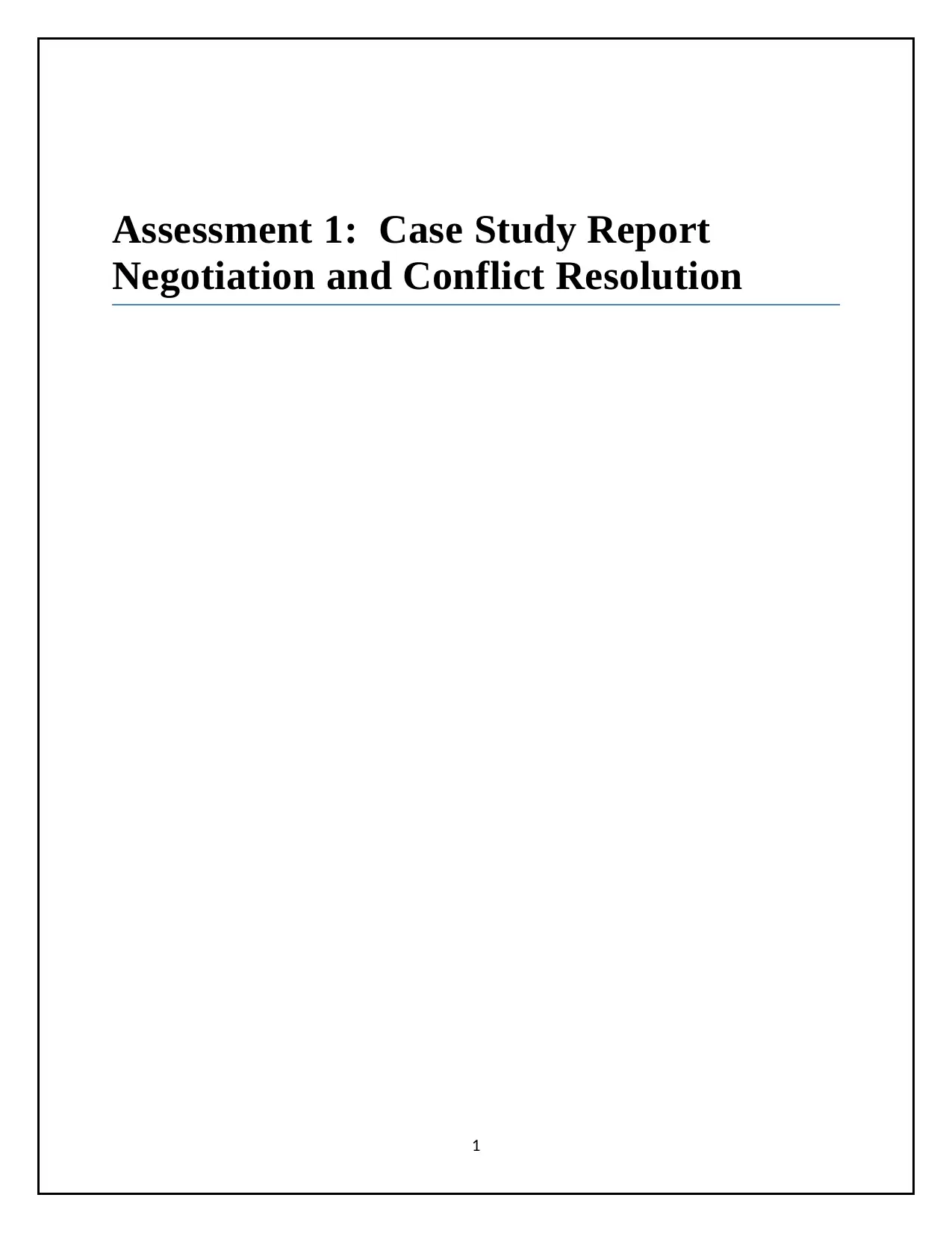
Assessment 1: Case Study Report
Negotiation and Conflict Resolution
1
Negotiation and Conflict Resolution
1
Paraphrase This Document
Need a fresh take? Get an instant paraphrase of this document with our AI Paraphraser
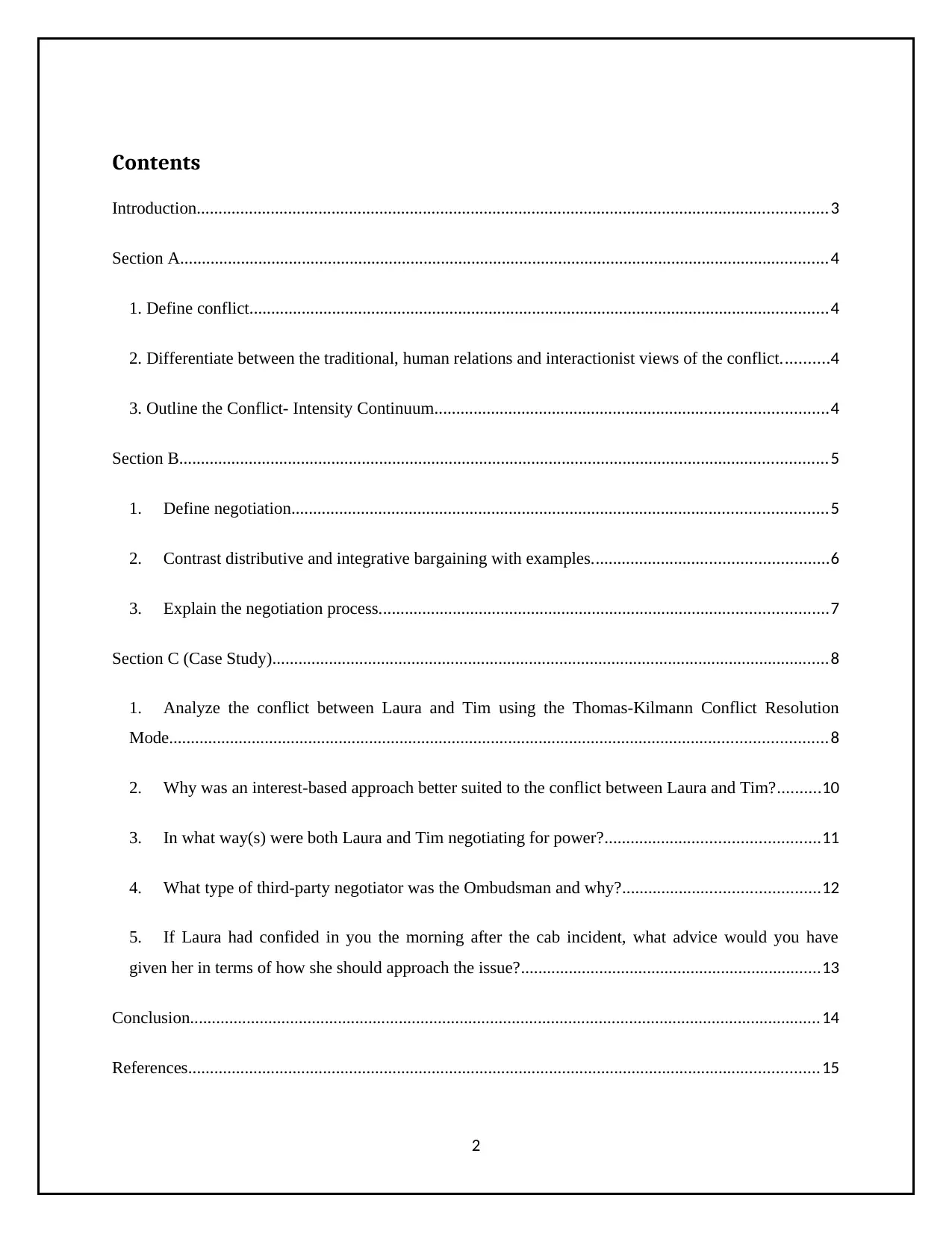
Contents
Introduction.................................................................................................................................................3
Section A.....................................................................................................................................................4
1. Define conflict.....................................................................................................................................4
2. Differentiate between the traditional, human relations and interactionist views of the conflict...........4
3. Outline the Conflict- Intensity Continuum..........................................................................................4
Section B.....................................................................................................................................................5
1. Define negotiation...........................................................................................................................5
2. Contrast distributive and integrative bargaining with examples......................................................6
3. Explain the negotiation process.......................................................................................................7
Section C (Case Study)................................................................................................................................8
1. Analyze the conflict between Laura and Tim using the Thomas-Kilmann Conflict Resolution
Mode.......................................................................................................................................................8
2. Why was an interest-based approach better suited to the conflict between Laura and Tim?..........10
3. In what way(s) were both Laura and Tim negotiating for power?.................................................11
4. What type of third-party negotiator was the Ombudsman and why?.............................................12
5. If Laura had confided in you the morning after the cab incident, what advice would you have
given her in terms of how she should approach the issue?.....................................................................13
Conclusion.................................................................................................................................................14
References.................................................................................................................................................15
2
Introduction.................................................................................................................................................3
Section A.....................................................................................................................................................4
1. Define conflict.....................................................................................................................................4
2. Differentiate between the traditional, human relations and interactionist views of the conflict...........4
3. Outline the Conflict- Intensity Continuum..........................................................................................4
Section B.....................................................................................................................................................5
1. Define negotiation...........................................................................................................................5
2. Contrast distributive and integrative bargaining with examples......................................................6
3. Explain the negotiation process.......................................................................................................7
Section C (Case Study)................................................................................................................................8
1. Analyze the conflict between Laura and Tim using the Thomas-Kilmann Conflict Resolution
Mode.......................................................................................................................................................8
2. Why was an interest-based approach better suited to the conflict between Laura and Tim?..........10
3. In what way(s) were both Laura and Tim negotiating for power?.................................................11
4. What type of third-party negotiator was the Ombudsman and why?.............................................12
5. If Laura had confided in you the morning after the cab incident, what advice would you have
given her in terms of how she should approach the issue?.....................................................................13
Conclusion.................................................................................................................................................14
References.................................................................................................................................................15
2

3
⊘ This is a preview!⊘
Do you want full access?
Subscribe today to unlock all pages.

Trusted by 1+ million students worldwide
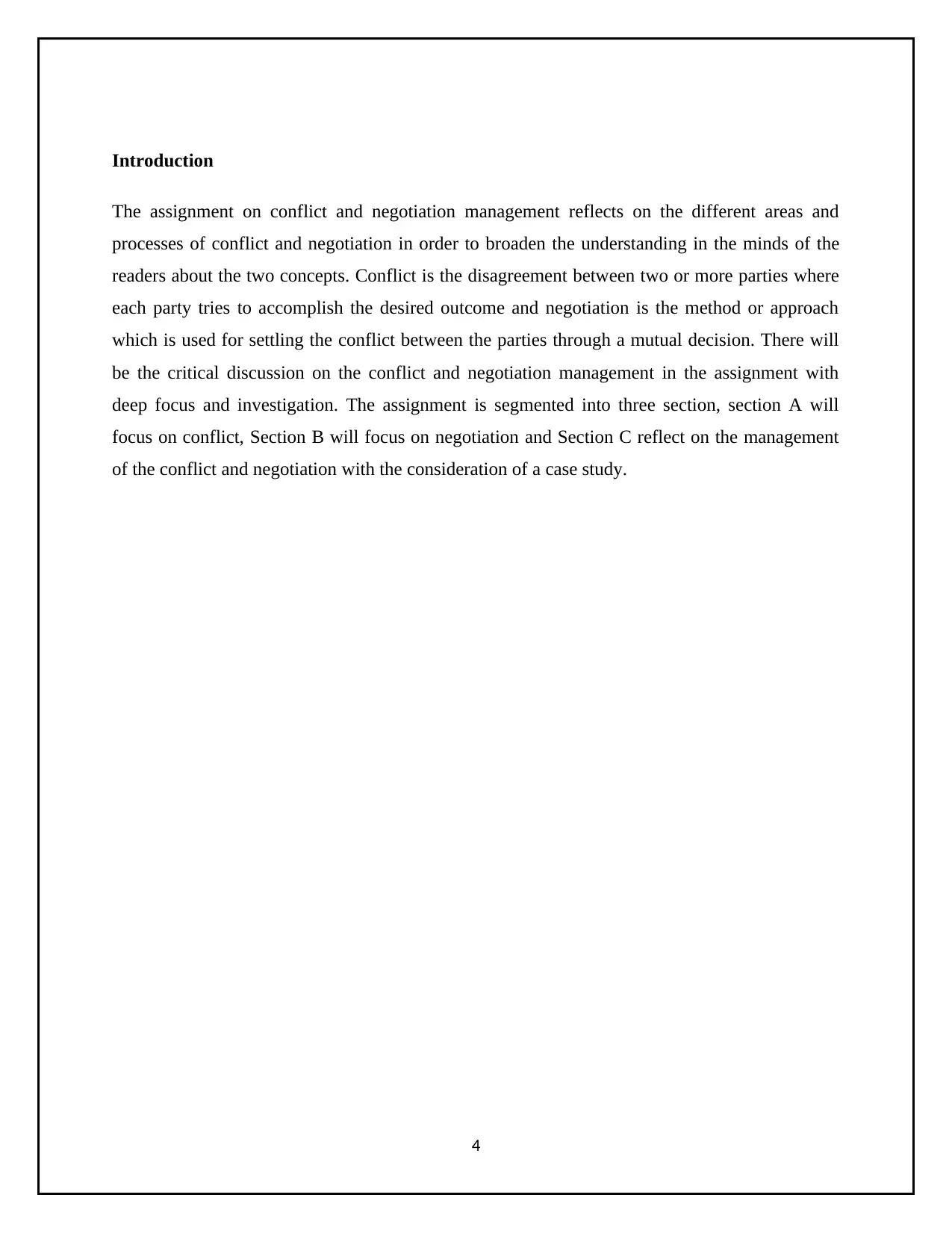
Introduction
The assignment on conflict and negotiation management reflects on the different areas and
processes of conflict and negotiation in order to broaden the understanding in the minds of the
readers about the two concepts. Conflict is the disagreement between two or more parties where
each party tries to accomplish the desired outcome and negotiation is the method or approach
which is used for settling the conflict between the parties through a mutual decision. There will
be the critical discussion on the conflict and negotiation management in the assignment with
deep focus and investigation. The assignment is segmented into three section, section A will
focus on conflict, Section B will focus on negotiation and Section C reflect on the management
of the conflict and negotiation with the consideration of a case study.
4
The assignment on conflict and negotiation management reflects on the different areas and
processes of conflict and negotiation in order to broaden the understanding in the minds of the
readers about the two concepts. Conflict is the disagreement between two or more parties where
each party tries to accomplish the desired outcome and negotiation is the method or approach
which is used for settling the conflict between the parties through a mutual decision. There will
be the critical discussion on the conflict and negotiation management in the assignment with
deep focus and investigation. The assignment is segmented into three section, section A will
focus on conflict, Section B will focus on negotiation and Section C reflect on the management
of the conflict and negotiation with the consideration of a case study.
4
Paraphrase This Document
Need a fresh take? Get an instant paraphrase of this document with our AI Paraphraser
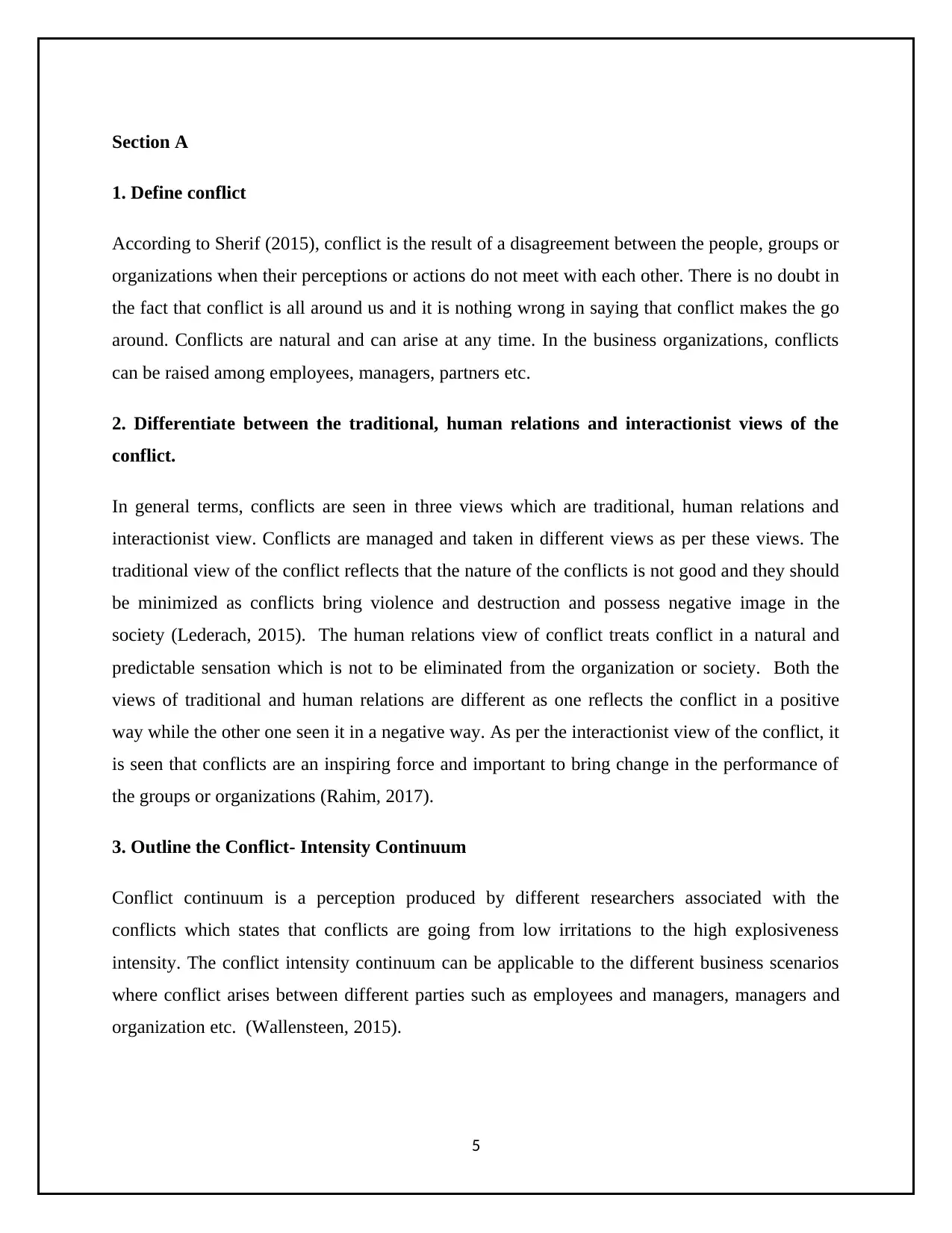
Section A
1. Define conflict
According to Sherif (2015), conflict is the result of a disagreement between the people, groups or
organizations when their perceptions or actions do not meet with each other. There is no doubt in
the fact that conflict is all around us and it is nothing wrong in saying that conflict makes the go
around. Conflicts are natural and can arise at any time. In the business organizations, conflicts
can be raised among employees, managers, partners etc.
2. Differentiate between the traditional, human relations and interactionist views of the
conflict.
In general terms, conflicts are seen in three views which are traditional, human relations and
interactionist view. Conflicts are managed and taken in different views as per these views. The
traditional view of the conflict reflects that the nature of the conflicts is not good and they should
be minimized as conflicts bring violence and destruction and possess negative image in the
society (Lederach, 2015). The human relations view of conflict treats conflict in a natural and
predictable sensation which is not to be eliminated from the organization or society. Both the
views of traditional and human relations are different as one reflects the conflict in a positive
way while the other one seen it in a negative way. As per the interactionist view of the conflict, it
is seen that conflicts are an inspiring force and important to bring change in the performance of
the groups or organizations (Rahim, 2017).
3. Outline the Conflict- Intensity Continuum
Conflict continuum is a perception produced by different researchers associated with the
conflicts which states that conflicts are going from low irritations to the high explosiveness
intensity. The conflict intensity continuum can be applicable to the different business scenarios
where conflict arises between different parties such as employees and managers, managers and
organization etc. (Wallensteen, 2015).
5
1. Define conflict
According to Sherif (2015), conflict is the result of a disagreement between the people, groups or
organizations when their perceptions or actions do not meet with each other. There is no doubt in
the fact that conflict is all around us and it is nothing wrong in saying that conflict makes the go
around. Conflicts are natural and can arise at any time. In the business organizations, conflicts
can be raised among employees, managers, partners etc.
2. Differentiate between the traditional, human relations and interactionist views of the
conflict.
In general terms, conflicts are seen in three views which are traditional, human relations and
interactionist view. Conflicts are managed and taken in different views as per these views. The
traditional view of the conflict reflects that the nature of the conflicts is not good and they should
be minimized as conflicts bring violence and destruction and possess negative image in the
society (Lederach, 2015). The human relations view of conflict treats conflict in a natural and
predictable sensation which is not to be eliminated from the organization or society. Both the
views of traditional and human relations are different as one reflects the conflict in a positive
way while the other one seen it in a negative way. As per the interactionist view of the conflict, it
is seen that conflicts are an inspiring force and important to bring change in the performance of
the groups or organizations (Rahim, 2017).
3. Outline the Conflict- Intensity Continuum
Conflict continuum is a perception produced by different researchers associated with the
conflicts which states that conflicts are going from low irritations to the high explosiveness
intensity. The conflict intensity continuum can be applicable to the different business scenarios
where conflict arises between different parties such as employees and managers, managers and
organization etc. (Wallensteen, 2015).
5
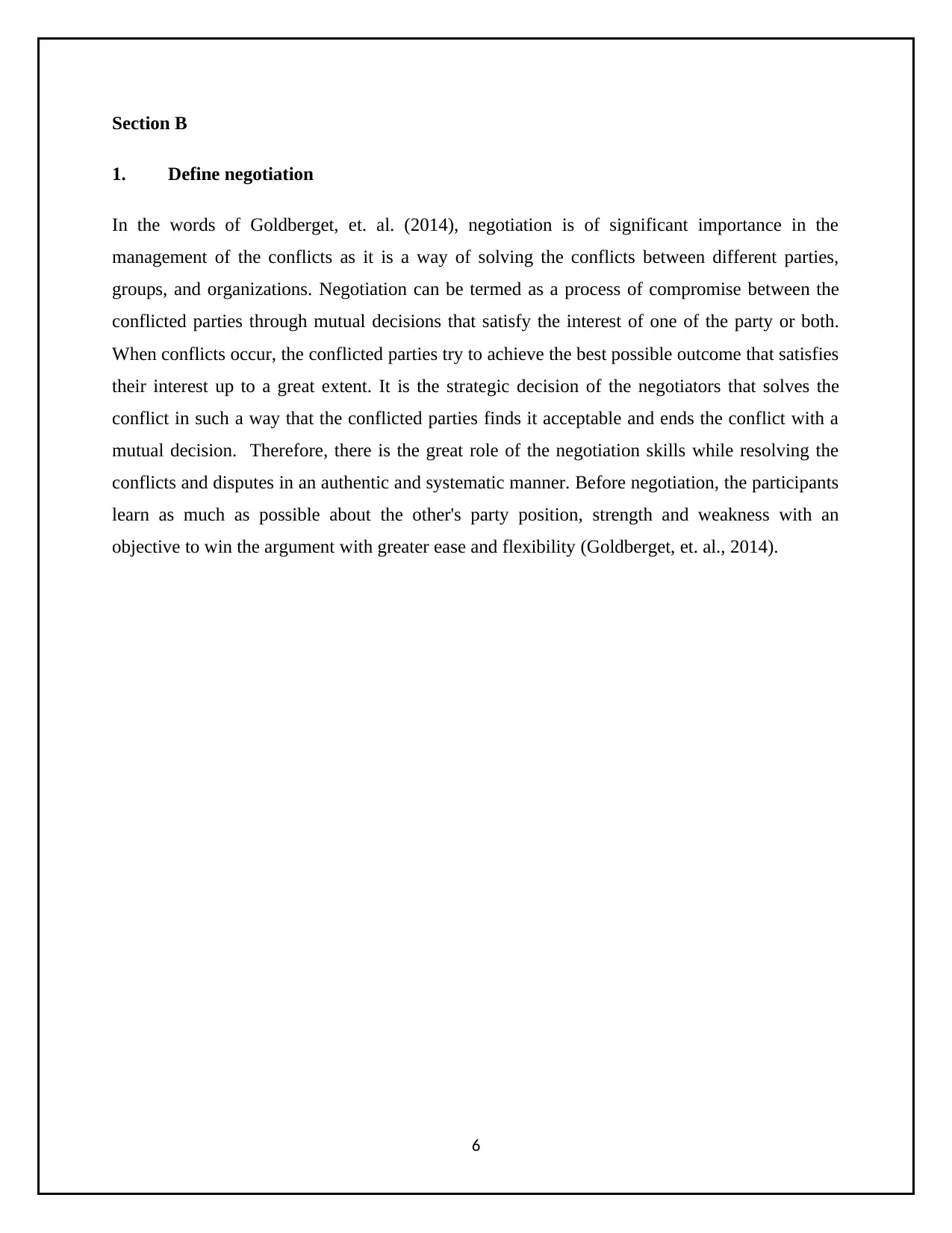
Section B
1. Define negotiation
In the words of Goldberget, et. al. (2014), negotiation is of significant importance in the
management of the conflicts as it is a way of solving the conflicts between different parties,
groups, and organizations. Negotiation can be termed as a process of compromise between the
conflicted parties through mutual decisions that satisfy the interest of one of the party or both.
When conflicts occur, the conflicted parties try to achieve the best possible outcome that satisfies
their interest up to a great extent. It is the strategic decision of the negotiators that solves the
conflict in such a way that the conflicted parties finds it acceptable and ends the conflict with a
mutual decision. Therefore, there is the great role of the negotiation skills while resolving the
conflicts and disputes in an authentic and systematic manner. Before negotiation, the participants
learn as much as possible about the other's party position, strength and weakness with an
objective to win the argument with greater ease and flexibility (Goldberget, et. al., 2014).
6
1. Define negotiation
In the words of Goldberget, et. al. (2014), negotiation is of significant importance in the
management of the conflicts as it is a way of solving the conflicts between different parties,
groups, and organizations. Negotiation can be termed as a process of compromise between the
conflicted parties through mutual decisions that satisfy the interest of one of the party or both.
When conflicts occur, the conflicted parties try to achieve the best possible outcome that satisfies
their interest up to a great extent. It is the strategic decision of the negotiators that solves the
conflict in such a way that the conflicted parties finds it acceptable and ends the conflict with a
mutual decision. Therefore, there is the great role of the negotiation skills while resolving the
conflicts and disputes in an authentic and systematic manner. Before negotiation, the participants
learn as much as possible about the other's party position, strength and weakness with an
objective to win the argument with greater ease and flexibility (Goldberget, et. al., 2014).
6
⊘ This is a preview!⊘
Do you want full access?
Subscribe today to unlock all pages.

Trusted by 1+ million students worldwide
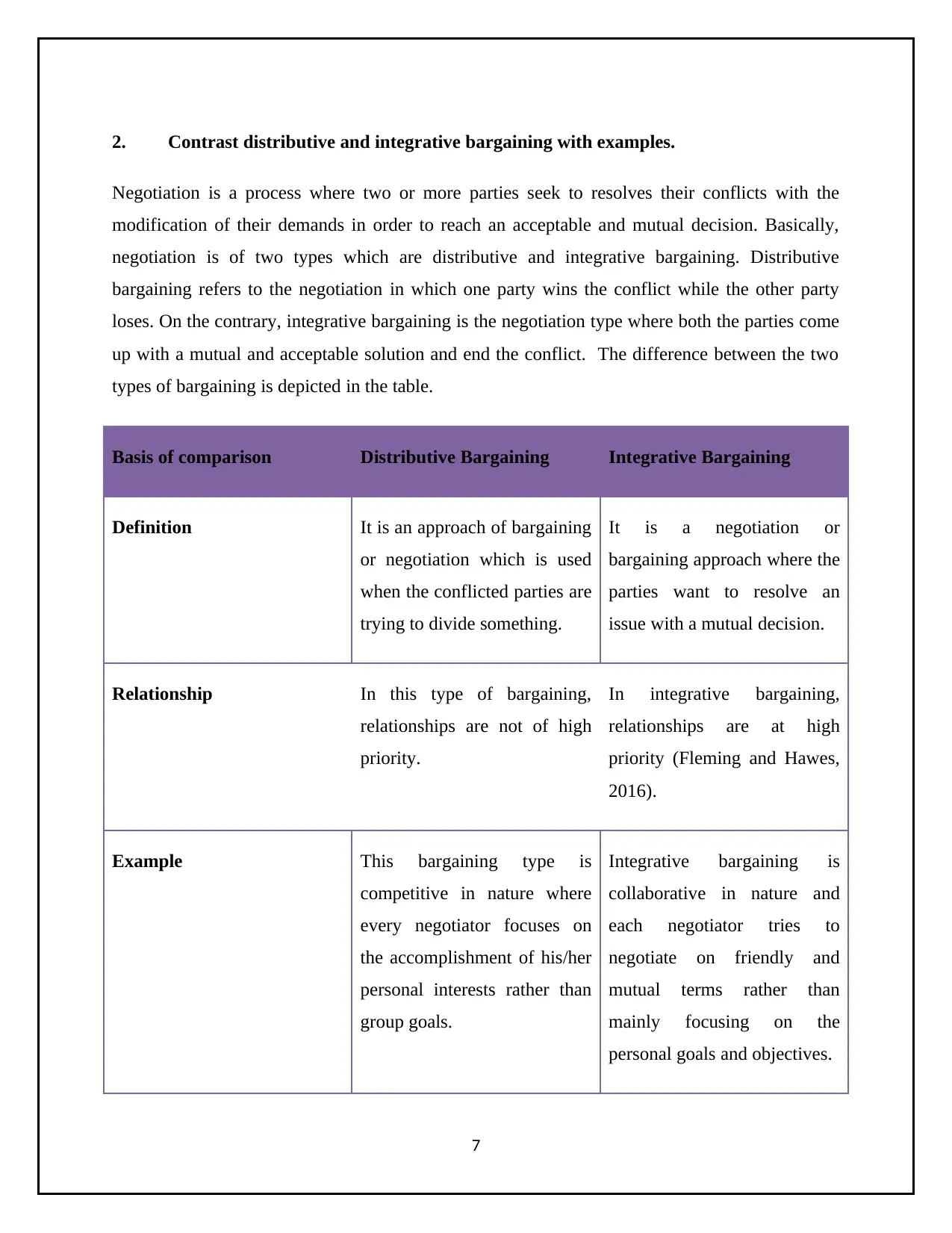
2. Contrast distributive and integrative bargaining with examples.
Negotiation is a process where two or more parties seek to resolves their conflicts with the
modification of their demands in order to reach an acceptable and mutual decision. Basically,
negotiation is of two types which are distributive and integrative bargaining. Distributive
bargaining refers to the negotiation in which one party wins the conflict while the other party
loses. On the contrary, integrative bargaining is the negotiation type where both the parties come
up with a mutual and acceptable solution and end the conflict. The difference between the two
types of bargaining is depicted in the table.
Basis of comparison Distributive Bargaining Integrative Bargaining
Definition It is an approach of bargaining
or negotiation which is used
when the conflicted parties are
trying to divide something.
It is a negotiation or
bargaining approach where the
parties want to resolve an
issue with a mutual decision.
Relationship In this type of bargaining,
relationships are not of high
priority.
In integrative bargaining,
relationships are at high
priority (Fleming and Hawes,
2016).
Example This bargaining type is
competitive in nature where
every negotiator focuses on
the accomplishment of his/her
personal interests rather than
group goals.
Integrative bargaining is
collaborative in nature and
each negotiator tries to
negotiate on friendly and
mutual terms rather than
mainly focusing on the
personal goals and objectives.
7
Negotiation is a process where two or more parties seek to resolves their conflicts with the
modification of their demands in order to reach an acceptable and mutual decision. Basically,
negotiation is of two types which are distributive and integrative bargaining. Distributive
bargaining refers to the negotiation in which one party wins the conflict while the other party
loses. On the contrary, integrative bargaining is the negotiation type where both the parties come
up with a mutual and acceptable solution and end the conflict. The difference between the two
types of bargaining is depicted in the table.
Basis of comparison Distributive Bargaining Integrative Bargaining
Definition It is an approach of bargaining
or negotiation which is used
when the conflicted parties are
trying to divide something.
It is a negotiation or
bargaining approach where the
parties want to resolve an
issue with a mutual decision.
Relationship In this type of bargaining,
relationships are not of high
priority.
In integrative bargaining,
relationships are at high
priority (Fleming and Hawes,
2016).
Example This bargaining type is
competitive in nature where
every negotiator focuses on
the accomplishment of his/her
personal interests rather than
group goals.
Integrative bargaining is
collaborative in nature and
each negotiator tries to
negotiate on friendly and
mutual terms rather than
mainly focusing on the
personal goals and objectives.
7
Paraphrase This Document
Need a fresh take? Get an instant paraphrase of this document with our AI Paraphraser
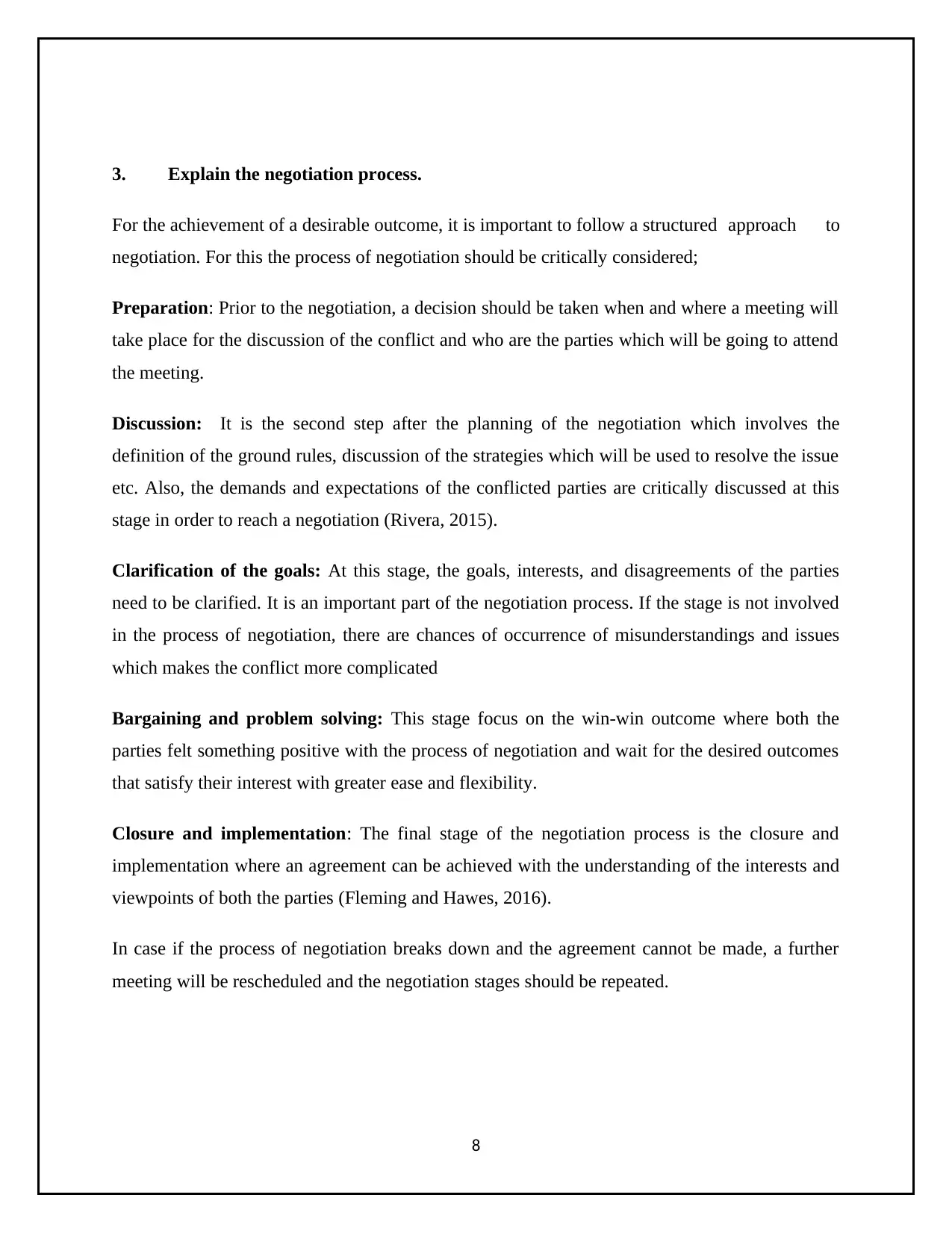
3. Explain the negotiation process.
For the achievement of a desirable outcome, it is important to follow a structured approach to
negotiation. For this the process of negotiation should be critically considered;
Preparation: Prior to the negotiation, a decision should be taken when and where a meeting will
take place for the discussion of the conflict and who are the parties which will be going to attend
the meeting.
Discussion: It is the second step after the planning of the negotiation which involves the
definition of the ground rules, discussion of the strategies which will be used to resolve the issue
etc. Also, the demands and expectations of the conflicted parties are critically discussed at this
stage in order to reach a negotiation (Rivera, 2015).
Clarification of the goals: At this stage, the goals, interests, and disagreements of the parties
need to be clarified. It is an important part of the negotiation process. If the stage is not involved
in the process of negotiation, there are chances of occurrence of misunderstandings and issues
which makes the conflict more complicated
Bargaining and problem solving: This stage focus on the win-win outcome where both the
parties felt something positive with the process of negotiation and wait for the desired outcomes
that satisfy their interest with greater ease and flexibility.
Closure and implementation: The final stage of the negotiation process is the closure and
implementation where an agreement can be achieved with the understanding of the interests and
viewpoints of both the parties (Fleming and Hawes, 2016).
In case if the process of negotiation breaks down and the agreement cannot be made, a further
meeting will be rescheduled and the negotiation stages should be repeated.
8
For the achievement of a desirable outcome, it is important to follow a structured approach to
negotiation. For this the process of negotiation should be critically considered;
Preparation: Prior to the negotiation, a decision should be taken when and where a meeting will
take place for the discussion of the conflict and who are the parties which will be going to attend
the meeting.
Discussion: It is the second step after the planning of the negotiation which involves the
definition of the ground rules, discussion of the strategies which will be used to resolve the issue
etc. Also, the demands and expectations of the conflicted parties are critically discussed at this
stage in order to reach a negotiation (Rivera, 2015).
Clarification of the goals: At this stage, the goals, interests, and disagreements of the parties
need to be clarified. It is an important part of the negotiation process. If the stage is not involved
in the process of negotiation, there are chances of occurrence of misunderstandings and issues
which makes the conflict more complicated
Bargaining and problem solving: This stage focus on the win-win outcome where both the
parties felt something positive with the process of negotiation and wait for the desired outcomes
that satisfy their interest with greater ease and flexibility.
Closure and implementation: The final stage of the negotiation process is the closure and
implementation where an agreement can be achieved with the understanding of the interests and
viewpoints of both the parties (Fleming and Hawes, 2016).
In case if the process of negotiation breaks down and the agreement cannot be made, a further
meeting will be rescheduled and the negotiation stages should be repeated.
8
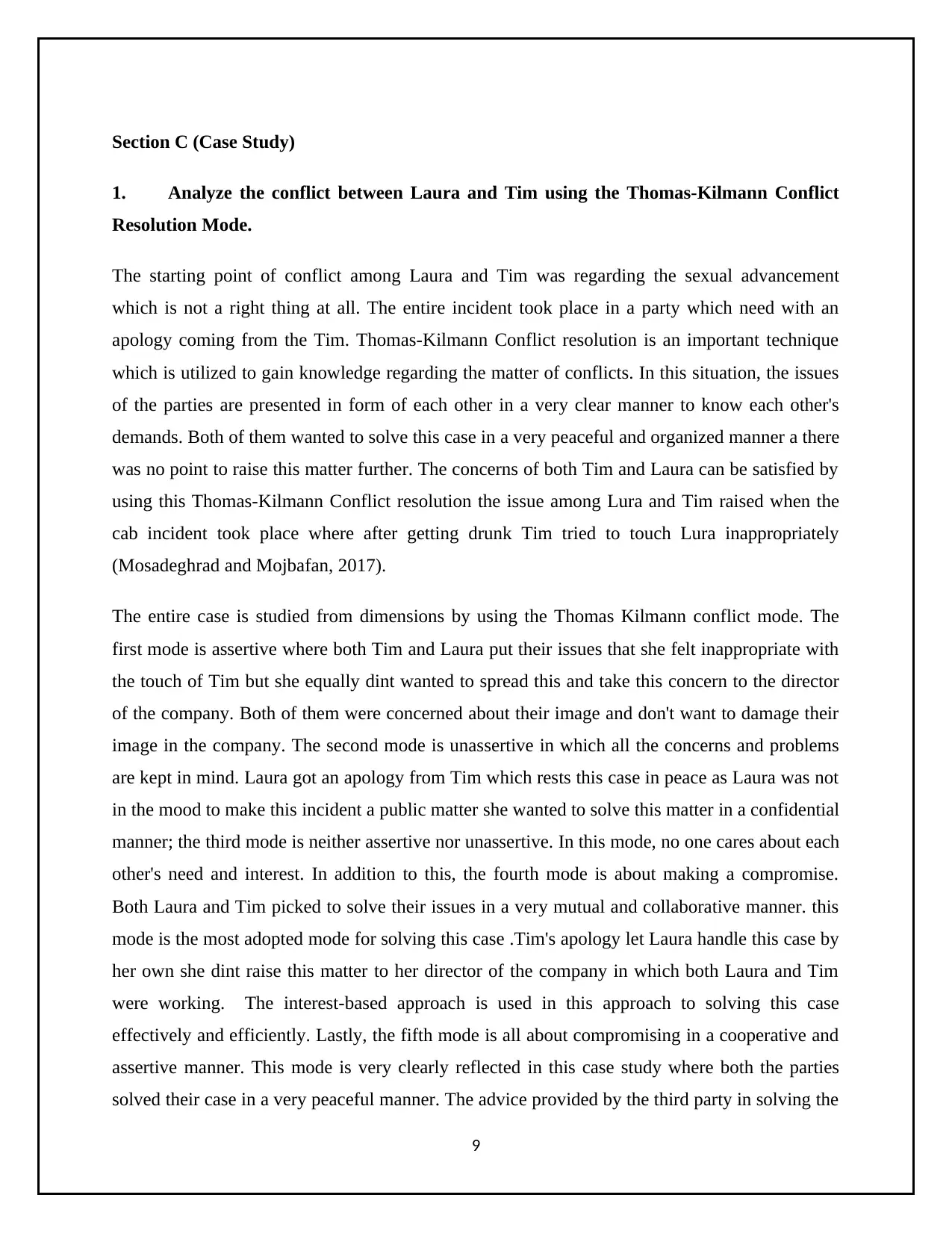
Section C (Case Study)
1. Analyze the conflict between Laura and Tim using the Thomas-Kilmann Conflict
Resolution Mode.
The starting point of conflict among Laura and Tim was regarding the sexual advancement
which is not a right thing at all. The entire incident took place in a party which need with an
apology coming from the Tim. Thomas-Kilmann Conflict resolution is an important technique
which is utilized to gain knowledge regarding the matter of conflicts. In this situation, the issues
of the parties are presented in form of each other in a very clear manner to know each other's
demands. Both of them wanted to solve this case in a very peaceful and organized manner a there
was no point to raise this matter further. The concerns of both Tim and Laura can be satisfied by
using this Thomas-Kilmann Conflict resolution the issue among Lura and Tim raised when the
cab incident took place where after getting drunk Tim tried to touch Lura inappropriately
(Mosadeghrad and Mojbafan, 2017).
The entire case is studied from dimensions by using the Thomas Kilmann conflict mode. The
first mode is assertive where both Tim and Laura put their issues that she felt inappropriate with
the touch of Tim but she equally dint wanted to spread this and take this concern to the director
of the company. Both of them were concerned about their image and don't want to damage their
image in the company. The second mode is unassertive in which all the concerns and problems
are kept in mind. Laura got an apology from Tim which rests this case in peace as Laura was not
in the mood to make this incident a public matter she wanted to solve this matter in a confidential
manner; the third mode is neither assertive nor unassertive. In this mode, no one cares about each
other's need and interest. In addition to this, the fourth mode is about making a compromise.
Both Laura and Tim picked to solve their issues in a very mutual and collaborative manner. this
mode is the most adopted mode for solving this case .Tim's apology let Laura handle this case by
her own she dint raise this matter to her director of the company in which both Laura and Tim
were working. The interest-based approach is used in this approach to solving this case
effectively and efficiently. Lastly, the fifth mode is all about compromising in a cooperative and
assertive manner. This mode is very clearly reflected in this case study where both the parties
solved their case in a very peaceful manner. The advice provided by the third party in solving the
9
1. Analyze the conflict between Laura and Tim using the Thomas-Kilmann Conflict
Resolution Mode.
The starting point of conflict among Laura and Tim was regarding the sexual advancement
which is not a right thing at all. The entire incident took place in a party which need with an
apology coming from the Tim. Thomas-Kilmann Conflict resolution is an important technique
which is utilized to gain knowledge regarding the matter of conflicts. In this situation, the issues
of the parties are presented in form of each other in a very clear manner to know each other's
demands. Both of them wanted to solve this case in a very peaceful and organized manner a there
was no point to raise this matter further. The concerns of both Tim and Laura can be satisfied by
using this Thomas-Kilmann Conflict resolution the issue among Lura and Tim raised when the
cab incident took place where after getting drunk Tim tried to touch Lura inappropriately
(Mosadeghrad and Mojbafan, 2017).
The entire case is studied from dimensions by using the Thomas Kilmann conflict mode. The
first mode is assertive where both Tim and Laura put their issues that she felt inappropriate with
the touch of Tim but she equally dint wanted to spread this and take this concern to the director
of the company. Both of them were concerned about their image and don't want to damage their
image in the company. The second mode is unassertive in which all the concerns and problems
are kept in mind. Laura got an apology from Tim which rests this case in peace as Laura was not
in the mood to make this incident a public matter she wanted to solve this matter in a confidential
manner; the third mode is neither assertive nor unassertive. In this mode, no one cares about each
other's need and interest. In addition to this, the fourth mode is about making a compromise.
Both Laura and Tim picked to solve their issues in a very mutual and collaborative manner. this
mode is the most adopted mode for solving this case .Tim's apology let Laura handle this case by
her own she dint raise this matter to her director of the company in which both Laura and Tim
were working. The interest-based approach is used in this approach to solving this case
effectively and efficiently. Lastly, the fifth mode is all about compromising in a cooperative and
assertive manner. This mode is very clearly reflected in this case study where both the parties
solved their case in a very peaceful manner. The advice provided by the third party in solving the
9
⊘ This is a preview!⊘
Do you want full access?
Subscribe today to unlock all pages.

Trusted by 1+ million students worldwide
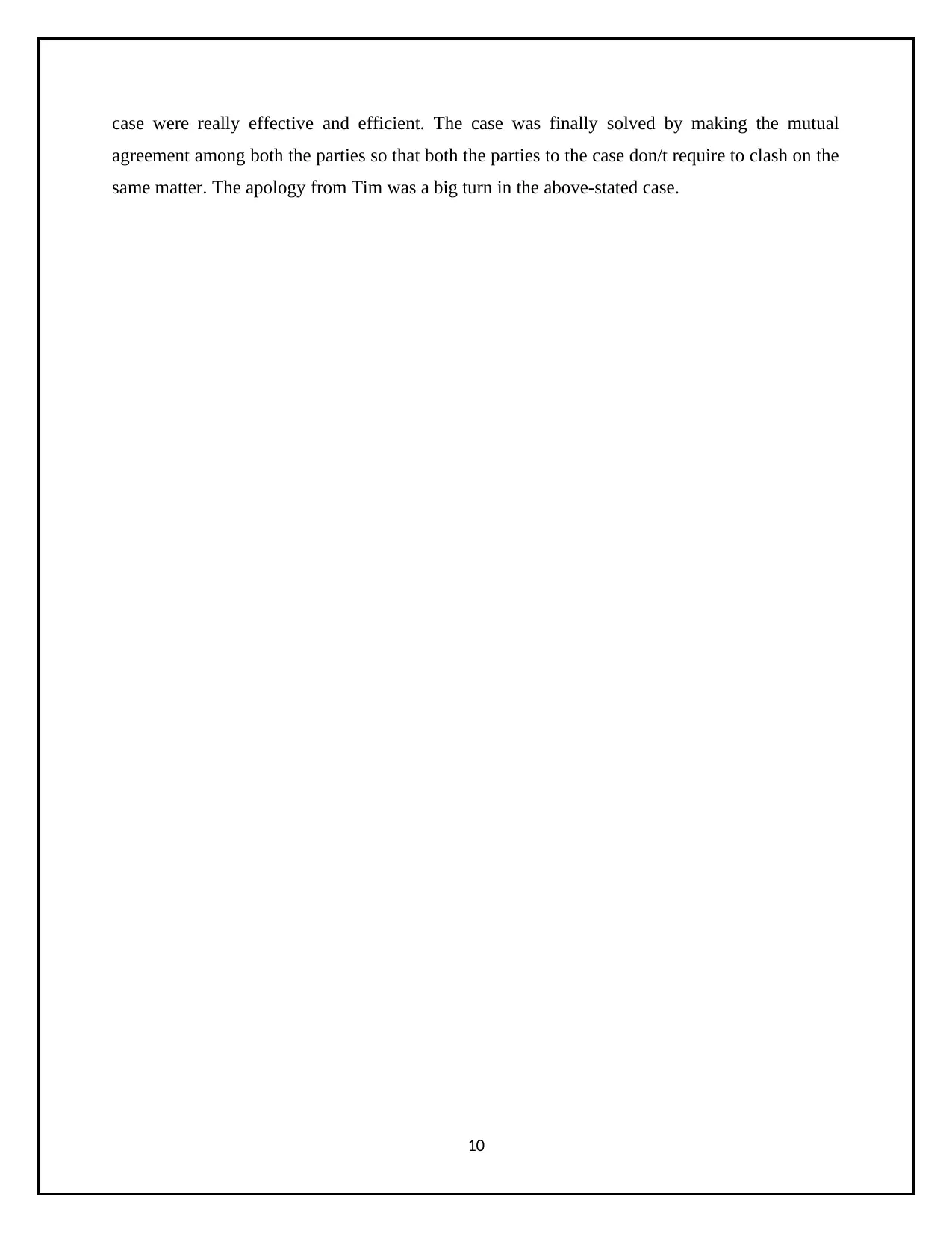
case were really effective and efficient. The case was finally solved by making the mutual
agreement among both the parties so that both the parties to the case don/t require to clash on the
same matter. The apology from Tim was a big turn in the above-stated case.
10
agreement among both the parties so that both the parties to the case don/t require to clash on the
same matter. The apology from Tim was a big turn in the above-stated case.
10
Paraphrase This Document
Need a fresh take? Get an instant paraphrase of this document with our AI Paraphraser
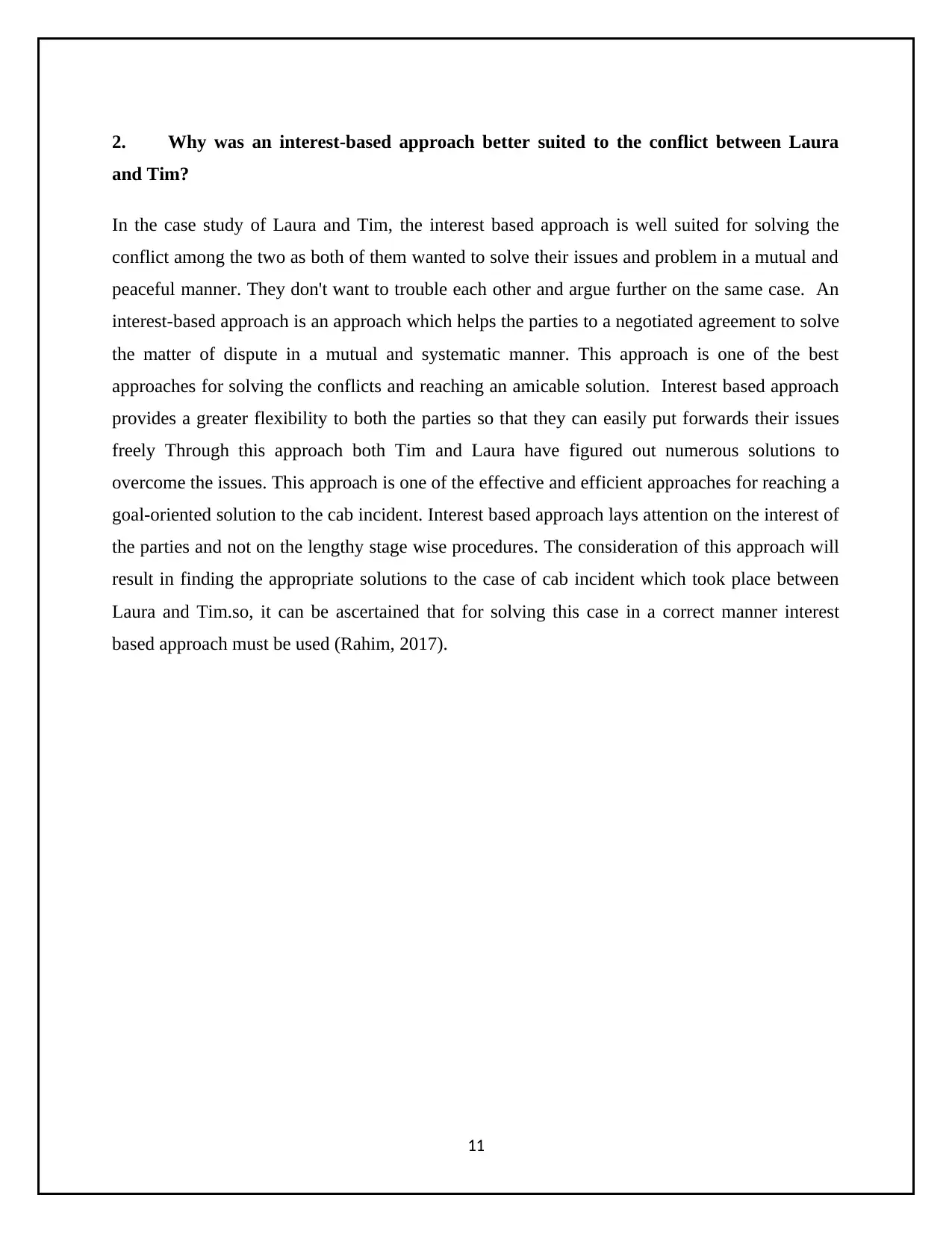
2. Why was an interest-based approach better suited to the conflict between Laura
and Tim?
In the case study of Laura and Tim, the interest based approach is well suited for solving the
conflict among the two as both of them wanted to solve their issues and problem in a mutual and
peaceful manner. They don't want to trouble each other and argue further on the same case. An
interest-based approach is an approach which helps the parties to a negotiated agreement to solve
the matter of dispute in a mutual and systematic manner. This approach is one of the best
approaches for solving the conflicts and reaching an amicable solution. Interest based approach
provides a greater flexibility to both the parties so that they can easily put forwards their issues
freely Through this approach both Tim and Laura have figured out numerous solutions to
overcome the issues. This approach is one of the effective and efficient approaches for reaching a
goal-oriented solution to the cab incident. Interest based approach lays attention on the interest of
the parties and not on the lengthy stage wise procedures. The consideration of this approach will
result in finding the appropriate solutions to the case of cab incident which took place between
Laura and Tim.so, it can be ascertained that for solving this case in a correct manner interest
based approach must be used (Rahim, 2017).
11
and Tim?
In the case study of Laura and Tim, the interest based approach is well suited for solving the
conflict among the two as both of them wanted to solve their issues and problem in a mutual and
peaceful manner. They don't want to trouble each other and argue further on the same case. An
interest-based approach is an approach which helps the parties to a negotiated agreement to solve
the matter of dispute in a mutual and systematic manner. This approach is one of the best
approaches for solving the conflicts and reaching an amicable solution. Interest based approach
provides a greater flexibility to both the parties so that they can easily put forwards their issues
freely Through this approach both Tim and Laura have figured out numerous solutions to
overcome the issues. This approach is one of the effective and efficient approaches for reaching a
goal-oriented solution to the cab incident. Interest based approach lays attention on the interest of
the parties and not on the lengthy stage wise procedures. The consideration of this approach will
result in finding the appropriate solutions to the case of cab incident which took place between
Laura and Tim.so, it can be ascertained that for solving this case in a correct manner interest
based approach must be used (Rahim, 2017).
11
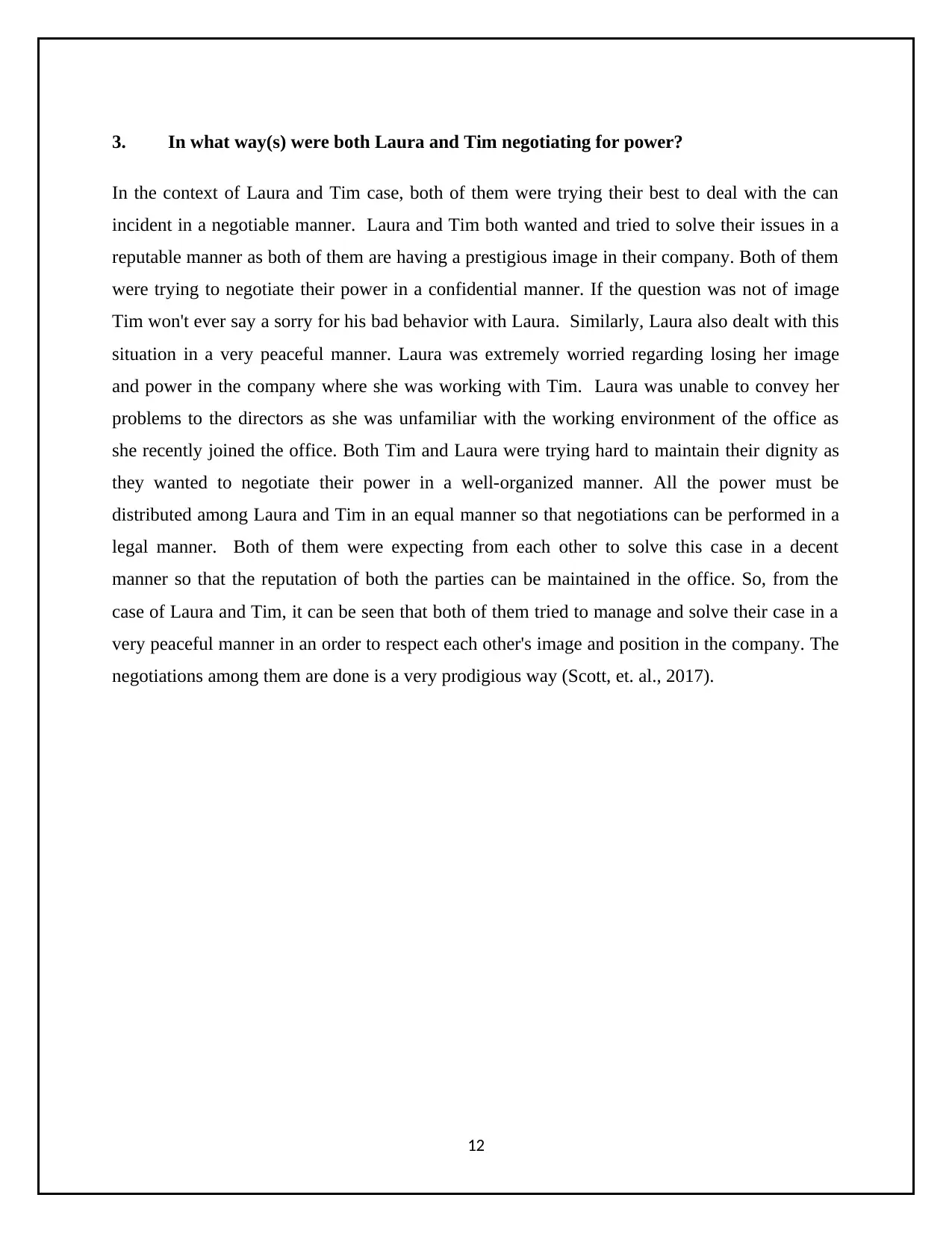
3. In what way(s) were both Laura and Tim negotiating for power?
In the context of Laura and Tim case, both of them were trying their best to deal with the can
incident in a negotiable manner. Laura and Tim both wanted and tried to solve their issues in a
reputable manner as both of them are having a prestigious image in their company. Both of them
were trying to negotiate their power in a confidential manner. If the question was not of image
Tim won't ever say a sorry for his bad behavior with Laura. Similarly, Laura also dealt with this
situation in a very peaceful manner. Laura was extremely worried regarding losing her image
and power in the company where she was working with Tim. Laura was unable to convey her
problems to the directors as she was unfamiliar with the working environment of the office as
she recently joined the office. Both Tim and Laura were trying hard to maintain their dignity as
they wanted to negotiate their power in a well-organized manner. All the power must be
distributed among Laura and Tim in an equal manner so that negotiations can be performed in a
legal manner. Both of them were expecting from each other to solve this case in a decent
manner so that the reputation of both the parties can be maintained in the office. So, from the
case of Laura and Tim, it can be seen that both of them tried to manage and solve their case in a
very peaceful manner in an order to respect each other's image and position in the company. The
negotiations among them are done is a very prodigious way (Scott, et. al., 2017).
12
In the context of Laura and Tim case, both of them were trying their best to deal with the can
incident in a negotiable manner. Laura and Tim both wanted and tried to solve their issues in a
reputable manner as both of them are having a prestigious image in their company. Both of them
were trying to negotiate their power in a confidential manner. If the question was not of image
Tim won't ever say a sorry for his bad behavior with Laura. Similarly, Laura also dealt with this
situation in a very peaceful manner. Laura was extremely worried regarding losing her image
and power in the company where she was working with Tim. Laura was unable to convey her
problems to the directors as she was unfamiliar with the working environment of the office as
she recently joined the office. Both Tim and Laura were trying hard to maintain their dignity as
they wanted to negotiate their power in a well-organized manner. All the power must be
distributed among Laura and Tim in an equal manner so that negotiations can be performed in a
legal manner. Both of them were expecting from each other to solve this case in a decent
manner so that the reputation of both the parties can be maintained in the office. So, from the
case of Laura and Tim, it can be seen that both of them tried to manage and solve their case in a
very peaceful manner in an order to respect each other's image and position in the company. The
negotiations among them are done is a very prodigious way (Scott, et. al., 2017).
12
⊘ This is a preview!⊘
Do you want full access?
Subscribe today to unlock all pages.

Trusted by 1+ million students worldwide
1 out of 16
Related Documents
Your All-in-One AI-Powered Toolkit for Academic Success.
+13062052269
info@desklib.com
Available 24*7 on WhatsApp / Email
![[object Object]](/_next/static/media/star-bottom.7253800d.svg)
Unlock your academic potential
Copyright © 2020–2025 A2Z Services. All Rights Reserved. Developed and managed by ZUCOL.





